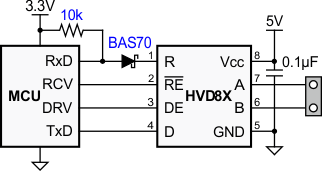ZHCSB94C July 2013 – January 2018 SN65HVD888
PRODUCTION DATA.
9.1.5 3- to 5-V Interface
Interfacing the SN65HVD888 to a 3-V controller is easy. Because the 5-V logic inputs of the transceiver accept 3-V input signals they can be directly connected to the controller I/O. The 5-V receiver output, R, however must be level-shifted by a Schottky diode and a 10-k resistor to connect to the controller input (see Figure 19). When R is high, the diode is reverse biased and the controller supply potential lies at the controller RxD input. When R is low, the diode is forward biased and conducts. In this case only the diode forward voltage of 0.2 V lies at the controller RxD input.
 Figure 19. 3-V to 5-V Interface
Figure 19. 3-V to 5-V Interface